Fionn Mc Inerney
The Computational Complexity of Positive Non-Clashing Teaching in Graphs
Mar 08, 2025Abstract:We study the classical and parameterized complexity of computing the positive non-clashing teaching dimension of a set of concepts, that is, the smallest number of examples per concept required to successfully teach an intelligent learner under the considered, previously established model. For any class of concepts, it is known that this problem can be effortlessly transferred to the setting of balls in a graph G. We establish (1) the NP-hardness of the problem even when restricted to instances with positive non-clashing teaching dimension k=2 and where all balls in the graph are present, (2) near-tight running time upper and lower bounds for the problem on general graphs, (3) fixed-parameter tractability when parameterized by the vertex integrity of G, and (4) a lower bound excluding fixed-parameter tractability when parameterized by the feedback vertex number and pathwidth of G, even when combined with k. Our results provide a nearly complete understanding of the complexity landscape of computing the positive non-clashing teaching dimension and answer open questions from the literature.
The Boundaries of Tractability in Hierarchical Task Network Planning
Jan 25, 2024Abstract:We study the complexity-theoretic boundaries of tractability for three classical problems in the context of Hierarchical Task Network Planning: the validation of a provided plan, whether an executable plan exists, and whether a given state can be reached by some plan. We show that all three problems can be solved in polynomial time on primitive task networks of constant partial order width (and a generalization thereof), whereas for the latter two problems this holds only under a provably necessary restriction to the state space. Next, we obtain an algorithmic meta-theorem along with corresponding lower bounds to identify tight conditions under which general polynomial-time solvability results can be lifted from primitive to general task networks. Finally, we enrich our investigation by analyzing the parameterized complexity of the three considered problems, and show that (1) fixed-parameter tractability for all three problems can be achieved by replacing the partial order width with the vertex cover number of the network as the parameter, and (2) other classical graph-theoretic parameters of the network (including treewidth, treedepth, and the aforementioned partial order width) do not yield fixed-parameter tractability for any of the three problems.
The Complexity of Optimizing Atomic Congestion
Dec 15, 2023Abstract:Atomic congestion games are a classic topic in network design, routing, and algorithmic game theory, and are capable of modeling congestion and flow optimization tasks in various application areas. While both the price of anarchy for such games as well as the computational complexity of computing their Nash equilibria are by now well-understood, the computational complexity of computing a system-optimal set of strategies -- that is, a centrally planned routing that minimizes the average cost of agents -- is severely understudied in the literature. We close this gap by identifying the exact boundaries of tractability for the problem through the lens of the parameterized complexity paradigm. After showing that the problem remains highly intractable even on extremely simple networks, we obtain a set of results which demonstrate that the structural parameters which control the computational (in)tractability of the problem are not vertex-separator based in nature (such as, e.g., treewidth), but rather based on edge separators. We conclude by extending our analysis towards the (even more challenging) min-max variant of the problem.
Non-Clashing Teaching Maps for Balls in Graphs
Sep 06, 2023

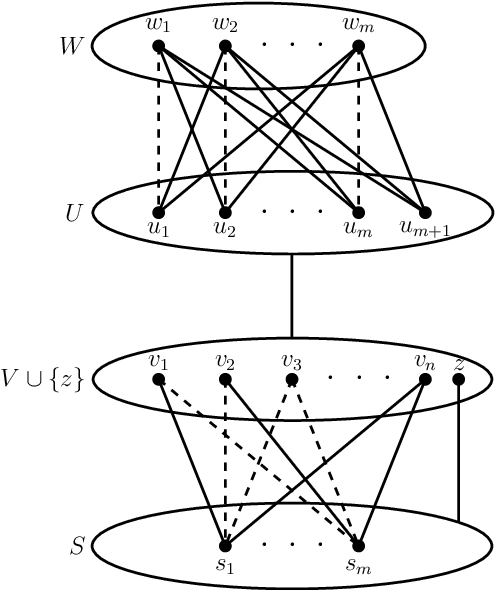
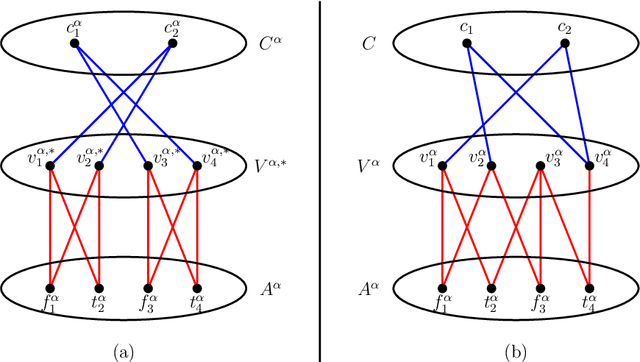
Abstract:Recently, Kirkpatrick et al. [ALT 2019] and Fallat et al. [JMLR 2023] introduced non-clashing teaching and showed it to be the most efficient machine teaching model satisfying the benchmark for collusion-avoidance set by Goldman and Mathias. A teaching map $T$ for a concept class $\cal{C}$ assigns a (teaching) set $T(C)$ of examples to each concept $C \in \cal{C}$. A teaching map is non-clashing if no pair of concepts are consistent with the union of their teaching sets. The size of a non-clashing teaching map (NCTM) $T$ is the maximum size of a $T(C)$, $C \in \cal{C}$. The non-clashing teaching dimension NCTD$(\cal{C})$ of $\cal{C}$ is the minimum size of an NCTM for $\cal{C}$. NCTM$^+$ and NCTD$^+(\cal{C})$ are defined analogously, except the teacher may only use positive examples. We study NCTMs and NCTM$^+$s for the concept class $\mathcal{B}(G)$ consisting of all balls of a graph $G$. We show that the associated decision problem {\sc B-NCTD$^+$} for NCTD$^+$ is NP-complete in split, co-bipartite, and bipartite graphs. Surprisingly, we even prove that, unless the ETH fails, {\sc B-NCTD$^+$} does not admit an algorithm running in time $2^{2^{o(vc)}}\cdot n^{O(1)}$, nor a kernelization algorithm outputting a kernel with $2^{o(vc)}$ vertices, where vc is the vertex cover number of $G$. These are extremely rare results: it is only the second (fourth, resp.) problem in NP to admit a double-exponential lower bound parameterized by vc (treewidth, resp.), and only one of very few problems to admit an ETH-based conditional lower bound on the number of vertices in a kernel. We complement these lower bounds with matching upper bounds. For trees, interval graphs, cycles, and trees of cycles, we derive NCTM$^+$s or NCTMs for $\mathcal{B}(G)$ of size proportional to its VC-dimension. For Gromov-hyperbolic graphs, we design an approximate NCTM$^+$ for $\mathcal{B}(G)$ of size 2.
Sample compression schemes for balls in graphs
Jun 27, 2022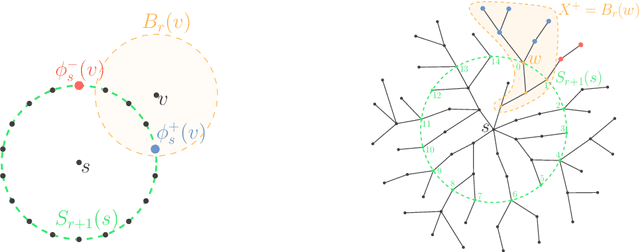
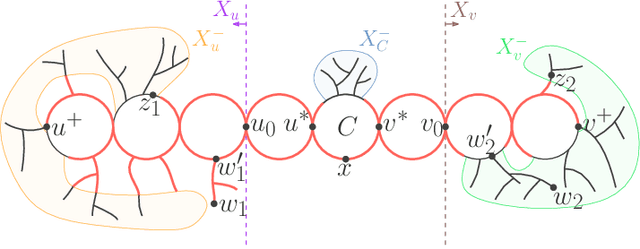
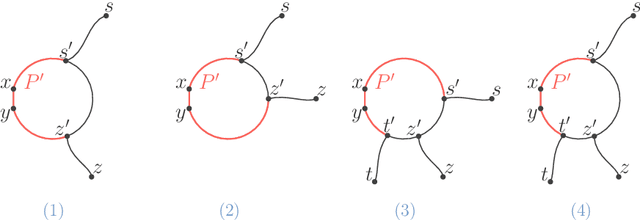

Abstract:One of the open problems in machine learning is whether any set-family of VC-dimension $d$ admits a sample compression scheme of size~$O(d)$. In this paper, we study this problem for balls in graphs. For balls of arbitrary radius $r$, we design proper sample compression schemes of size $2$ for trees, of size $3$ for cycles, of size $4$ for interval graphs, of size $6$ for trees of cycles, and of size $22$ for cube-free median graphs. For balls of a given radius, we design proper labeled sample compression schemes of size $2$ for trees and of size $4$ for interval graphs. We also design approximate sample compression schemes of size 2 for balls of $\delta$-hyperbolic graphs.
 Add to Chrome
Add to Chrome Add to Firefox
Add to Firefox Add to Edge
Add to Edge